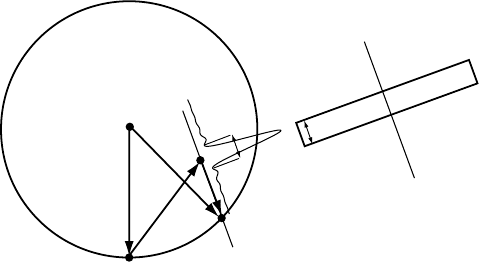Graef M. Introduction to conventional transmission electron microscopy
Подождите немного. Документ загружается.


118 Basic quantum mechanics
The probability P is given by the bra-ket:
P =
4
e
2πik
·r
#
#
V (r)
#
#
e
2πik·r
5
,
=
g
V
g
4
e
2πik
·r
#
#
e
2πig·r
#
#
e
2πik·r
5
,
=
g
V
g
...
e
2πi(k+g−k
)·r
dr,
=
g
V
g
δ(k + g − k
).
This expression is only different from zero whenever k + g = k
, which is the Bragg
equation in reciprocal space. In such a situation, the probability amplitude P is
equal to the Fourier coefficient V
g
.
Example 2.4 Determine for which reciprocal lattice vectors g the Fourier coeffi-
cient V
g
(equation 2.83) vanishes in a structure with a face-centered cubic lattice.
Answer: The summation over all the atoms in the unit cell can be written as a sum-
mation over one-quarter of the atoms and a summation over all atoms equivalent
to each other by the Bravais lattice N
c
centering vectors R
k
:
V
g
=
1
N
j=1
f
e
j
e
−2πig·r
j
;
=
1
N/4
j=1
f
e
j
e
−2πig·r
j
N
c
k=1
e
−2πig·R
k
;
=
1
N/4
j=1
f
e
j
e
−2πig·r
j
$
1 + e
−πig·(a+b)
+ e
−πig·(a+c)
+ e
−πig·(b+c)
%
;
=
$
1 + (−1)
h+k
+ (−1)
h+l
+ (−1)
k+l
%
1
N/4
j=1
f
e
j
e
−2πig·r
j
.
We have used the fact that g · (a + b) = h + k, and also e
−πin
= (−1)
−n
= (−1)
n
.
All reciprocal lattice points for which the Miller indices have mixed parity have
a vanishing Fourier coefficient V
g
, and will not give rise to a diffracted beam.
Reflections which are absent because of the Bravais lattice centering symmetry are
known as systematic absences or systematic extinctions.

2.6 The electrostatic lattice potential 119
2.6.3 Finite crystal size effects
We define the shape function D(r) of a crystal as a function which equals 1 inside
the crystal and 0 outside:
D(r) =
6
1 inside;
0 outside.
(2.85)
The finite crystal potential V
f
(r) then becomes the product of the potential for the
infinite crystal and the shape function:
V
f
(r) = V (r)D(r). (2.86)
We can now apply the multiplication theorem to determine how the finite character
of the crystal affects the Fourier transform of the lattice potential:
V
f
(q) = F[V (r)] ⊗ F[D(r)].
Since the δ-function is the identity operator for the convolution product, we find,
after substitution of equation (2.84):
V
f
(q) =
g
V
g
D(q − g). (2.87)
The Fourier transform of the lattice potential of a finite crystal is, hence, described
by a similar formula as for the infinite crystal, except that the reciprocal lattice
points now have a certain shape in reciprocal space. The exact shape of this volume
is determined by the external shape of the crystal. Let us consider two examples
of importance to electron microscopy: a planar thin foil, and a finite rectangular
crystal.
Example 2.5 Compute the reciprocal shape function D(q), also known as the shape
amplitude, for a thin foil of thickness z
0
with parallel top and bottom surfaces.
Answer: Taking the origin of the reference frame in the center of the foil, and the
z-direction normal to the foil, the reciprocal shape function is given by
D(q) =
.
+∞
−∞
e
−2πiq
x
x
dx
.
+∞
−∞
e
−2πiq
y
y
dy
.
+z
0
/2
−z
0
/2
e
−2πiq
z
z
dz;
=−δ(q
x
)δ(q
y
)
e
−2πiq
z
z
2πiq
z
z
0
/2
−z
0
/2
,

120 Basic quantum mechanics
-2π-4π 2π 4π
0
πq
z
z
0
D
D
2
1.0
0.8
0.6
0.4
0.2
0.0
-0.2
q
x
q
y
~1/A
~1/B
(a) (b)
Fig. 2.10. (a) Reciprocal shape functions D and D
2
for a thin foil of thickness z
0
along the
direction normal to the foil surface; (b) contour plot of a planar cut through
the reciprocal
shape function of a rectangular crystal D
2
(q
x
, q
y
, 0).
which results in
D(q) = z
0
δ(q
x
)δ(q
y
)
sin(πq
z
z
0
)
πq
z
z
0
.
Fig. 2.10(a) shows the function D(0, 0, q
z
)/z
0
and its square.
Example 2.6 Compute the reciprocal shape function D(q) for a rectangular crystal
with dimensions A, B, and C.
Answer: Using the same reference frame as in the previous example, and carrying
out three identical integrations, we have
D(q) =
.
+A/2
−A/2
e
−2πiq
x
x
dx
.
+B/2
−B/2
e
−2πiq
y
y
dy
.
+C/2
−C/2
e
−2πiq
z
z
dz;
= ABC
sin(π Aq
x
)
π Aq
x
sin(π Bq
y
)
π Bq
y
sin(πCq
z
)
πCq
z
.
The square of this function is shown in Fig. 2.10(b) as a contour plot D
2
(q
x
, q
y
, 0).
As we will see in the next chapter, nearly all TEM observations are carried
out with a circular electron beam; in other words, the illuminated volume in the
specimen is to a good approximation cylindrical with top and bottom surfaces not
necessarily flat or parallel. Since the illuminated volume is always finite, but with
2.6 The electrostatic lattice potential 121
a diameter that depends on the beam diameter, the volume and shape of reciprocal
lattice points will vary with the incident beam “shape” and the shape function
D(r) is determined by the intersection of the incident beam and the specimen. For
typical thin foils used in TEM the third dimension (usually the z-axis) is much
smaller than the lateral dimensions (see the first example above) and therefore the
reciprocal lattice points will be shaped as rods with their length axes perpendicular
to the foil. Since these rods reside in reciprocal space, they are called reciprocal
lattice rods or relrods.
We conclude from the examples above that, for a finite crystal, every reciprocal
lattice point is extended infinitely in reciprocal space, but, because of the rapidly
decreasing character of these functions, each point can be approximated by a finite
volume in reciprocal space. The shape of this volume can become quite complicated
for samples which have a non-rectangular shape. In Section 9.8 on page 575 we
will discuss in detail how the shape amplitude D(q) for a polyhedral particle can
be calculated analytically.
Another important consequence of the finiteness of a crystal is that the Bragg
condition for diffraction can be relaxed; whereas diffraction by an infinite crystal
requires a mathematical point to coincide with the surface of the reflecting sphere
(a rather improbable event), diffraction by a finite crystal becomes more probable
because of the extent of the reciprocal lattice points.
2.6.4 The excitation error or deviation parameter s
g
Since diffraction is possible even when the Bragg relation is not precisely satisfied,
it is useful to have a parameter that measures the deviation from the exact Bragg
orientation. For a thin foil, the Fourier transform of the shape function can be
approximated by a relrod, as we have seen in the previous section. The deviation
from the exact Bragg orientation can then be measured as the distance between the
reciprocal lattice point and the Ewald sphere along the major axis of the relrod, or,
equivalently, along the foil normal. We represent this distance by a vector s = se
z
,
with e
z
the unit normal to the foil, pointing down towards the viewing screen of the
microscope such that k · e
z
is positive.
The length of the vector s can be computed as follows: from the equation for the
Ewald sphere (2.43) we have
(g + s) · (2k + g + s) = 0,
since the vector g + s ends on the Ewald sphere, by construction. This relation can
be rewritten as
2(k + g) · s + s
2
=−g · (2k + g); (2.88)

122 Basic quantum mechanics
we recognize the equation of the Ewald sphere on the right-hand side of this equa-
tion. If the angle between k + g and the foil normal is denoted by α, then we also
have
s +
s
2
2|k + g|cos α
=
−g · (2k + g)
2|k + g|cos α
≡ s
g
. (2.89)
We introduce
†
the new variable s
g
which is equal to the right-hand side of the
equation above; s
g
is known as the excitation error or the deviation parameter.Ithas
units of reciprocal distance, since it is measured in reciprocal space. For relativistic
electrons we have |k + g|≈|k|, which is of the order of several hundred nm
−1
(see Table 2.2); the second term on the left-hand side of equation (2.89) is thus
very small and can be safely ignored. The deviation parameter s
g
is then to a very
good approximation equal to the distance s between the reciprocal lattice point g
and the Ewald sphere, measured along the relrod. The difference between s
g
and
s increases with decreasing acceleration voltage and only becomes important for
low-energy electron diffraction.
According to Fig. 2.5(a), g · (2k + g) is negative when g is inside the Ewald
sphere, which means that the excitation error s
g
defined in equation (2.89) is posi-
tive when the reciprocal lattice point g lies inside the Ewald sphere. s
g
is negative
when g lies outside the Ewald sphere, and is equal to zero when the Bragg orien-
tation is exactly satisfied. The deviation parameter is entirely determined by the
orientation of the crystal lattice with respect to the Ewald sphere, and is therefore
an experimental parameter. The microscope operator has full control over the mag-
nitude and sign of the deviation parameter. The degree to which s
g
can be varied
is determined by the type of specimen holder used for the observations; we will
discuss the major types of specimen holders in Section 3.9.2. The deviation param-
eter is one of the most important parameters for conventional TEM observations,
and, as we shall see in Chapters 6 and 8, the image contrast for both perfect and
defective crystals is to a large extent determined by the value of s
g
.
The excitation error can be computed numerically using the function
Calcsg in
the module
diffraction.f90. The function takes a g-vector, the incident wave vector
k, and the foil normal F as input, and returns the excitation error in nm
−1
.
2.6.5 Phenomenological treatment of absorption
In the preceding sections, we have only discussed elastic scattering processes, dur-
ing which the electron energy does not change. This is an approximation of what
†
The reason for selecting this particular expression will become clear in Chapter 5 where we will derive the
dynamical diffraction equations. The deviation parameter as defined above appears directly in those equations.

2.6 The electrostatic lattice potential 123
k
0
C
g
k'
s
k' = k + g + s
Foil normal
2/t
t
Fig. 2.11. Definition of the excitation error in terms of the incident and diffracted wave
vectors and the reciprocal lattice vector g. The excitation error is measured along the normal
to the foil surface, or, equivalently, along the relrod. The angles between the v
ectors are
greatly exaggerated; in reality g is nearly perpendicular to k (for electron diffraction).
really happens when a beam electron interacts with the crystal. An electron can
exchange energy with the crystal in a variety of processes, which are commonly
grouped under the name inelastic scattering processes. Electrons that are inelasti-
cally scattered no longer travel in the directions predicted by the Bragg equation, and
give rise to a background image intensity, which reduces the contrast of the elastic
image.
The interaction between the beam electron and the crystal can be taken into
account by including the ground state and excited states of the crystal in the
Schr¨odinger equation. Following Yoshioka [Yos57], we write the Schr¨odinger equa-
tion as
ˆ
T +
ˆ
H
cr
+
ˆ
H
int
|=E
t
|, (2.90)
where
ˆ
H
cr
is the crystal Hamiltonian, and
ˆ
H
int
is the electrostatic (Coulomb) in-
teraction term between the beam electron and the crystal. The wave function |
represents the state of the crystal and the beam electron, and can therefore be written
as the product of two wave functions:
|=
n
|ψ
n
|a
n
, (2.91)
where the functions |a
n
represent the nth excited state of the crystal (|a
0
is the
ground state). The beam electron wave function is given by |ψ
n
, for an electron
that leaves the crystal in the excited state |a
n
. The crystal wave functions |a
n
are
the eigenfunctions of the crystal Hamiltonian
ˆ
H
cr
|a
n
=
n
|a
n
,
124 Basic quantum mechanics
where
n
is the energy of the excited state. The crystal wave functions contain all
the information about lattice excitations, including phonons, plasmons, excitons,
polarons, and so on. The computation of the |a
n
is therefore a non-trivial problem,
which lies at the heart of solid-state physics.
If we assume that the crystal wave functions and energies are known, then we
can substitute equation (2.91) into (2.90) and multiply the resulting equation by the
state a
m
|. Since a
m
|a
n
=δ
mn
for a complete set of functions, we find
E
t
−
m
−
ˆ
T
|ψ
m
=
n
a
m
|
ˆ
H
int
|a
n
|ψ
n
≡
n
H
mn
|ψ
n
, (2.92)
where we have introduced the matrix elements H
mn
of the electrostatic interaction
between beam electron and crystal. These elements describe the probability am-
plitude that a beam electron will change the excitation state of the crystal from the
state |a
n
to the state |a
m
. For elastic scattering, the crystal state does not change,
and, hence, the diagonal matrix elements H
nn
describe elastic scattering processes.
Equation (2.92) is usually rewritten as a set of two equations, commonly known as
the Yoshioka equations [Yos57], by separating out the term m = 0:
E
t
−
0
−
ˆ
T − H
00
|ψ
0
=
n=0
H
0n
|ψ
n
; (2.93)
E
t
−
m
−
ˆ
T − H
mm
|ψ
m
=
n=m
H
mn
|ψ
n
. (2.94)
In the absence of inelastic scattering, the off-diagonal matrix elements H
mn
(m = n)
vanish, and the right-hand sides of both Yoshioka equations vanish. The diagonal
term on the left-hand side represents the interaction of the electron with the crystal,
and is commonly known as the potential energy of the beam electron in the crystal.
We have already seen that in the ground state of the crystal this potential energy is
given by H
00
= eV(r).
The computation of the matrix elements H
mn
is a difficult problem in general
and one usually approaches the computation of inelastic scattering probabilities by
only considering one effect at a time; e.g. the contribution of phonons, or plasmons,
and so on. Such computations are beyond the scope of this book. We refer to
Z.L. Wang’s book Elastic and Inelastic Scattering in Electron Diffraction and
Imaging for a recent review of inelastic scattering [Wan95]. We will instead use
the phenomenological approach of Moli`ere [Mol39] for x-ray diffraction, which
was first applied to electron diffraction by Honjo and Mihama [HM54]; Yoshioka
[Yos57] showed formally that inelastic scattering in electron diffraction can be
taken into account by adding a complex potential W (r) to the electrostatic lattice
potential. The imaginary part of this potential describes the inelastic scattering
processes in the form of an attenuation of the wave amplitude (absorption); the real

2.6 The electrostatic lattice potential 125
part of W (r) is associated with virtual inelastic scattering and has been shown by
P. Rez [Rez78] to be small for high-energy electrons. We will hence assume that
the so-called optical potential W (r) is purely imaginary and of the form iW (r).
Next, we show that such an imaginary term can describe absorption: following
[GBA66] we have
V (r) → V
c
(r) = V (r) + iW (r). (2.95)
Now consider the time-dependent Schr¨odinger equation:
i h
∂
∂t
=−
h
2
2m
− eV
c
, (2.96)
where V
c
is the complex lattice potential defined in equation (2.95). The complex
conjugate of this equation is given by
−i h
∂
∗
∂t
=−
h
2
2m
∗
− eV
∗
c
∗
. (2.97)
Multiplying the first equation by
∗
, the second by , and subtracting the second
from the first results in
i h
∂
∗
∂t
=−
h
2
2m
(
∗
−
∗
) − e
V
c
− V
∗
c
∗
. (2.98)
This in turn can be rewritten as
∂
∗
∂t
−
i h
2m
∇·(
∗
∇ − ∇
∗
) =
ie
h
V
c
− V
∗
c
∗
. (2.99)
Since
∗
= ρ equals the probability density and the argument of the divergence
operator is the electron flux J,
†
we can rewrite this equation one more time (using
equation 2.95):
∂ρ
∂t
+∇·J =−
2e
h
Wρ. (2.100)
We thus find that, if W > 0, then the total number of electrons will decrease with
time, i.e. absorption will occur. If W = 0, then equation (2.100) reduces to a stan-
dard continuity equation for the probability density. Note that this description does
not contain any details concerning the exact nature of the inelastic scattering pro-
cess; all that is required to describe absorption is the positive imaginary part of the
lattice potential.
For the remainder of this book we will use the phenomenological description of
absorption and inelastic scattering contributions.
†
See, for instance, [LL74].

126 Basic quantum mechanics
2.6.6 Atomic vibrations and the electrostatic lattice potential
The derivation of the atomic scattering factor f
e
(s) assumed that the atom was at
rest at the origin of the reference frame. In reality, atoms vibrate around their equi-
librium lattice positions, and the amplitude of this vibration depends on the absolute
temperature. The theory of lattice vibrations (or phonons) is well developed, and
we refer the reader to [Bir84] for a detailed discussion of lattice dynamics.
Lattice vibration frequencies for most solids are in the range 10
10
–10
12
Hz.
A 200 keV electron travels at a velocity of v = 0.695c, which corresponds to a
distance of about 208
µmina10
−12
s time interval. This is very large compared to
the atomic dimensions, which means that subsequent electrons will “see” this atom
located at different positions, but essentially at rest for each individual electron.
Each atom, therefore, appears to be spread out over a larger volume and this affects
the electron scattering factor f
e
(s). The correction factor is commonly known
as the Debye–Waller factor, and we will next derive an explicit expression based
on the definition of the atomic scattering factor.
Consider an isolated atom at rest at the origin, with atomic potential V
a
(r). The
atomic scattering factor f
e
(s) expresses the probability amplitude that an incident
electron with wave vector k will be scattered by the atom in the direction k
; this is
expressed by the bra-ket:
f
e
(k) =
4
e
2πik
·r
#
#
V
a
(r)
#
#
e
2πik·r
5
.
Assume next that the atom vibrates around this equilibrium position with a vibration
amplitude u(t). For simplicity and without loss of generality we will assume that
the vibration occurs along the x-direction. The instantaneous atomic potential at a
time t is given by
V
a
(r, t) = V
a
(r + u(t)) = V
a
(r + u(t)e
x
).
For small vibration amplitudes the instantaneous potential can be expanded in a
Taylor series in u, as follows (dropping the argument r):
V
a
(t) = V
a
+
u(t)
1!
dV
a
dx
#
#
#
#
u=0
+
u(t)
2
2!
d
2
V
a
dx
2
#
#
#
#
u=0
+····
If we average this expression over time, then all odd powers of u(t) will vanish,
since positive and negative excursions are equally likely over a sufficiently long
time interval. Denoting the time average by ,wehave
4
V
a
(t)
5
= V
a
+
u
2
2!
d
2
V
a
dx
2
#
#
#
#
u=0
+····

2.6 The electrostatic lattice potential 127
Next, we can calculate how the atomic scattering factor is modified by this average
potential:
4
f
e
(k)
5
=
4
e
2πik
·r
#
#
4
V
a
(t)
5
#
#
e
2πik·r
5
;
=
...
e
−2πik·r
V
a
+
4
u
2
5
2!
d
2
V
a
dx
2
#
#
#
#
u=0
+···
dr;
=
+
1 + (2π ik)
2
4
u
2
5
2!
+···
,
...
e
−2πik·r
V
a
dr;
≈ e
−2π
2
u
2
(k)
2
f
e
(k),
where we have used the relation F
u
[d
n
f (x)/dx
n
] = (2πiu)
n
f (u) (e.g. see [Cow81,
p. 32]). Introducing |k|=2s as before we arrive at the time-averaged atomic
scattering factor:
f
e
(s)= f
e
(s)e
−8π
2
u
2
s
2
= f
e
(s)e
−Bs
2
; (2.101)
the symbol B is proportional to the atomic mean-square vibration amplitude u
2
,
which is expressed in units of nm
2
and depends on absolute temperature. For
realistic simulations, the Debye–Waller factor must be taken into account. We
have assumed in this simplified derivation that the vibrations are isotropic. For
anisotropic vibrations B becomes a second-rank tensor, which can be represented
by a “vibrational ellipsoid”. The mean-square vibration amplitude then depends on
the particular reciprocal lattice vector g selected for the computation of f
e
(s).
The Debye–Waller factor B is a function of temperature B = B(T ); exact ex-
pressions for B can be derived for a given vibration model, and for details we refer
to the International Tables for Crystallography, volume C [Shm96], and references
therein. Note that B does not vanish at 0 K because of the zero-point motion of the
atoms.
For elemental solids, the Debye–Waller factor can be calculated from the phonon
density of states g(ω), using the following relation:
B(T ) =
4π
2
h
m
.
ω
m
0
coth
h
ω
2k
B
T
g(ω)
ω
dω,
where m is the atomic mass, T is the temperature (in kelvin), k
B
is the Boltzmann
constant, and ω
m
is the maximum phonon frequency. The phonon density of states
can be measured experimentally using neutron diffraction techniques. This relation
has been used by Gao and Peng [GP99] to parameterize the Debye–Waller factors
for 68 elemental crystals and a number of compounds in the temperature range
from T = 0 to 1000 K. The dashed lines in Fig. 2.9 represent the atomic scattering
